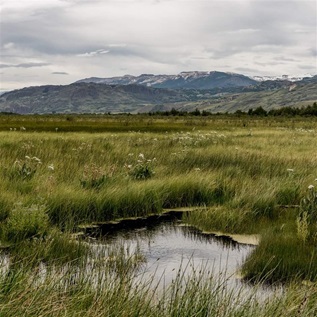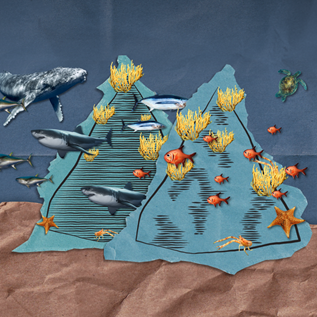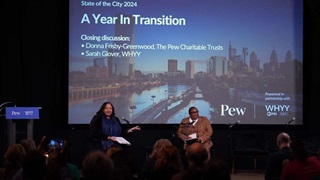Coalition Calls for Climate Action and Equitable Outcomes in New California Bond
More than 160 groups urge historic investment in the communities and natural resources most affected by climate change

Editor’s note: This article was updated May 6, 2024, to add Jos Hill as a co-author.
In California, as in most of the world, climate change is hitting hardest in the most vulnerable communities—those with the fewest resources to prepare for or respond and adapt to their shifting reality. Fortunately, there’s hope for relief: On Feb. 12, Pew joined more than 100 organizations to launch a California state legislative effort to place a bond initiative on the November 2024 ballot to support investments in the communities and natural resources most affected by climate change. The coalition has since grown to over 160 organizations.
The proposed bond is structured to ensure that more than 40% of the investments flow to disadvantaged communities that are overburdened by pollution; the bond would complement the Biden administration’s Justice40 Initiative. If it passes, the proposed $10 billion bond would represent the largest voter-approved climate resilience investment in U.S. history and would prioritize investments specifically requested by the communities most at risk from climate impacts.
“Our working-class communities of color are currently living through intensifying climate emergencies and compounding structural inequities,” Elle Chen, coalition member of the Asian Pacific Environmental Network (APEN), said in a recent conversation with California state legislators. “We have a unique opportunity as a collective to concretize Justice40 principles with real investments to our frontline communities facing cumulative impacts.”
Working collaboratively, Chen and other coalition members seek to provide California’s people and wildlife with better access to clean air, water, and open spaces. Additionally, the proposal calls for investments to better protect vulnerable communities from floods, fires, extreme heat, and other climate impacts.
‘Later is too late’
Climate change is harming California residents and industries in unprecedented ways. Disadvantaged and vulnerable communities are experiencing materially negative effects first and worst, through effects such as rising air pollution, increased allergens, extreme heat, and worsening droughts and wildfires, floods and storm surge, and declining water quality.
Numerous studies underscore the gravity of the situation in California:
- An Intergovernmental Panel on Climate Change report found that without prompt investment and commensurate action in nature, adaptation options that would benefit people today would not be effective in the future.
- Since 1980, the state has experienced 46 extreme weather events that caused at least $1 billion in damage, according to data from the National Oceanic and Atmospheric Administration’s National Centers for Environmental Information.
- According to California’s Fourth Climate Change Assessment, the state’s lands and waters—and the forestry, farming, fishing, ranching communities, and California Native American Tribes that depend on them—are under increased threat without substantial investments and adaptive management.
- In a 2023 report, the Association of Bay Area Governments, Metropolitan Transportation Commission, and San Francisco Bay Conservation and Development Commission concluded that it would cost $110 billion to protect residents from sea-level rise in the Bay Area, putting the $10 billion climate bond request from the coalition into perspective.
As the letter from the coalition states, “The time is now. Later is too late.”
Californians cherish the diversity of life in their communities
Despite being among the states most at risk for biodiversity loss, California remains a global biodiversity hotspot with the potential to sustain people and wildlife into the future. And public opinion research consistently indicates that Californians want to protect this biodiversity—their lands, air, water, and communities—and that they’re willing to pay for it.
The coalition’s climate bond proposal combines aspects of two proposed bills from the 2023 legislative session—S.B. 867 authored by State Senator Ben Allen (D) and A.B. 1567 authored by Assemblymember Eduardo Garcia (D)—and advances important environmental justice investments that were not included in those bills. Key elements of the proposed climate resilience bond include:
- Increasing access to safe drinking water and improving flood protection.
- Improving wildfire prevention and resilience, including by increasing forest health and addressing the impact of wildfires on human health.
- Restoring wetlands, reintroducing salmon, and improving forest health and habitat connectivity.
- Enhancing public areas to make communities more resilient to extreme heat events.
- Protecting and restoring coastal and tidal habitats to minimize flooding, erosion, and runoff.
- Incentivizing farmers and ranchers to improve how well their soil holds water and nutrients, sequesters carbon, and refills groundwater reservoirs (the water table).
- Improving air quality, increasing grid reliability, and creating local jobs through community projects to increase renewable energy, develop microgrids, and improve energy storage.
The California Legislature has until June 27 to pass legislation that would send the climate bond to the November ballot for voters to decide.
Jos Hill is a director and Bobby Hayden is an officer on The Pew Charitable Trusts’ U.S. conservation project.
Spotlight on Mental Health


California Should Invest in Lands, Air, Water, Communities
MORE FROM PEW
Explore Pew’s new and improved
Fiscal 50 interactive
Your state's stats are more accessible than ever with our new and improved Fiscal 50 interactive:
- Maps, trends, and customizable charts
- 50-state rankings
- Analysis of what it all means
- Shareable graphics and downloadable data
- Proven fiscal policy strategies
Welcome to the new Fiscal 50
Key changes include:
- State pages that help you keep track of trends in your home state and provide national and regional context.
- Interactive indicator pages with highly customizable and shareable data visualizations.
- A Budget Threads feature that offers Pew’s read on the latest state fiscal news.














